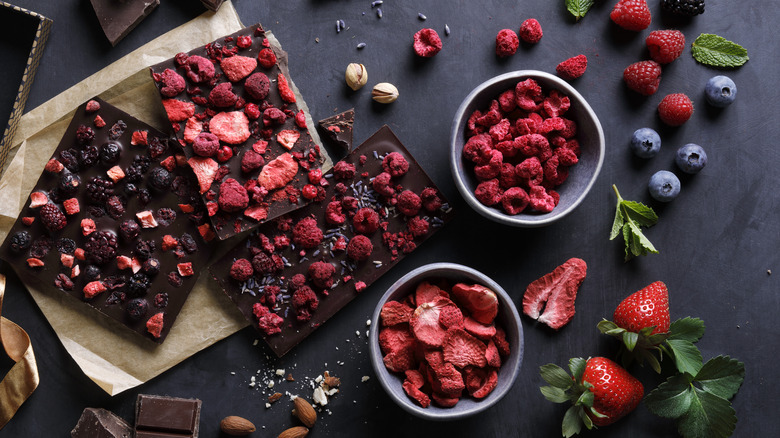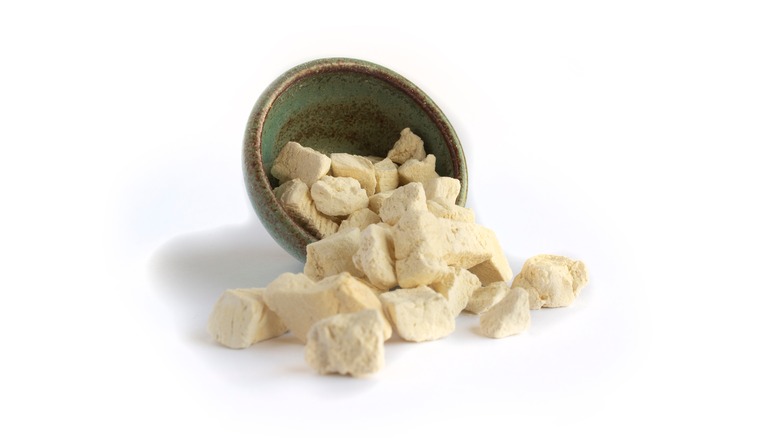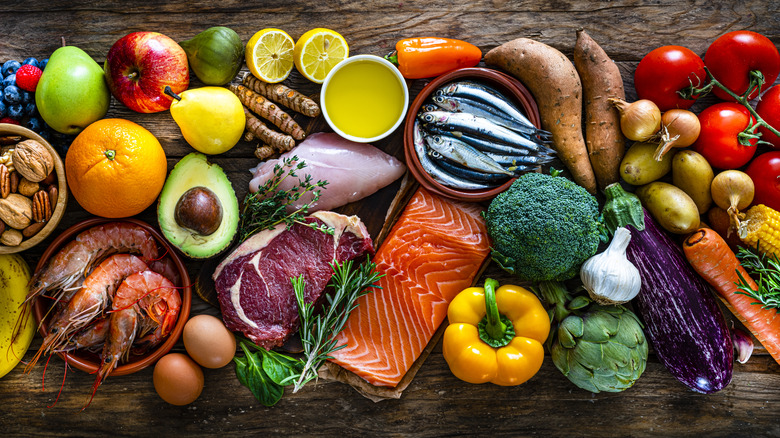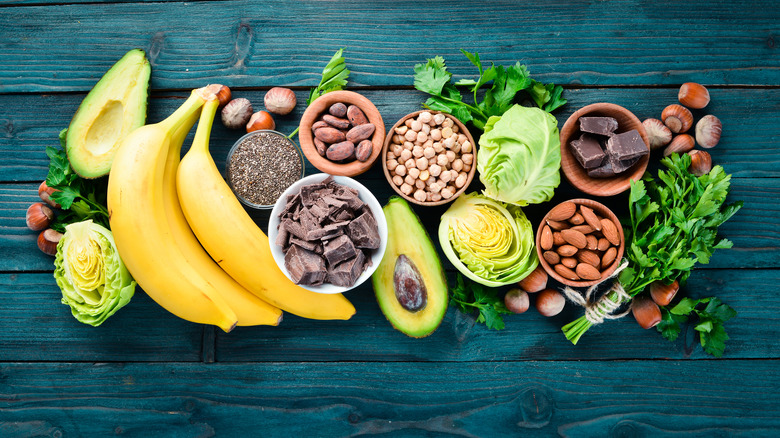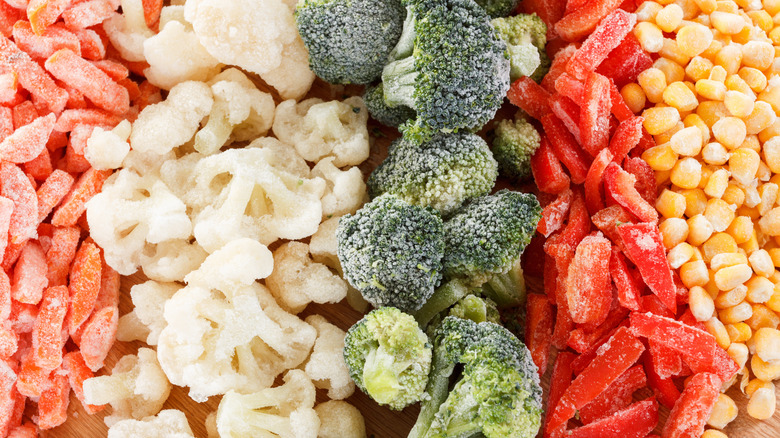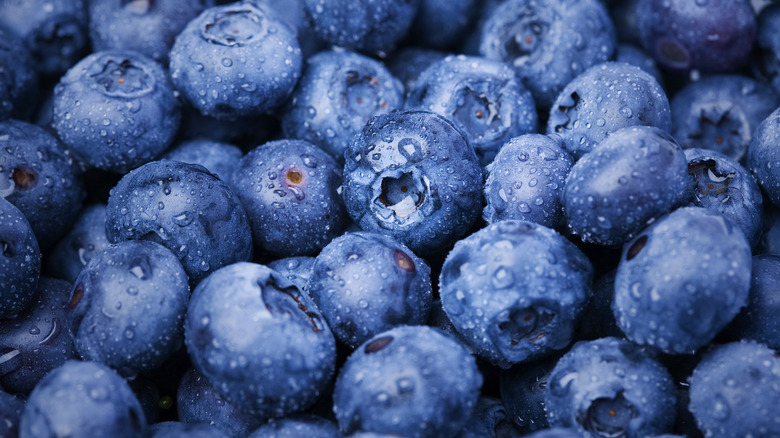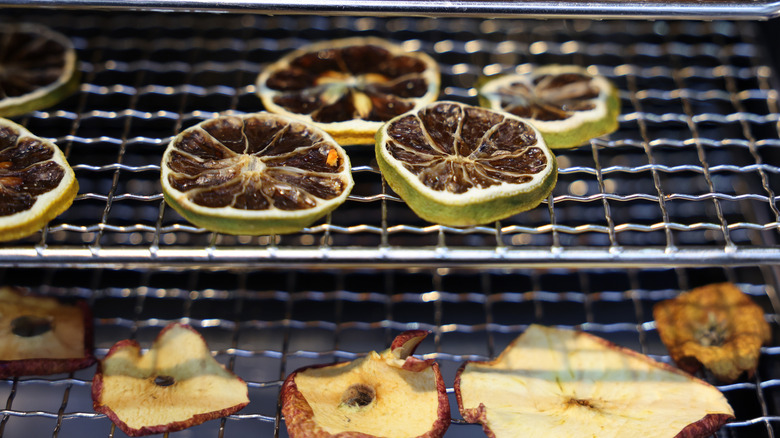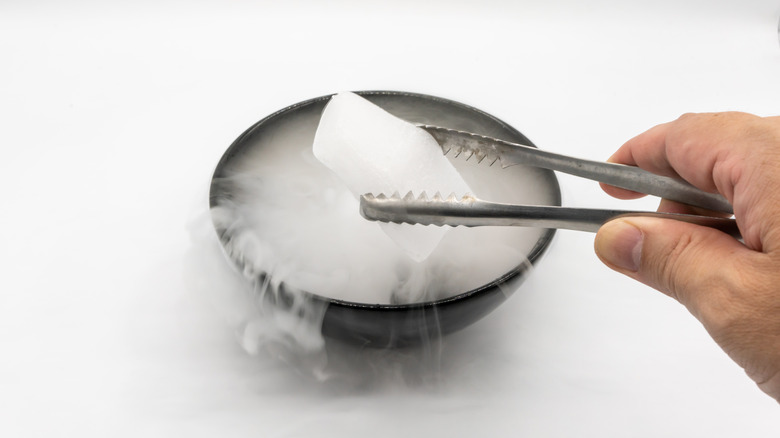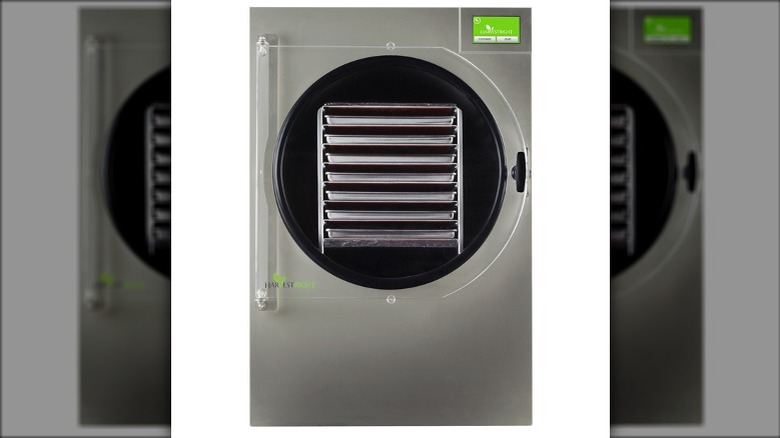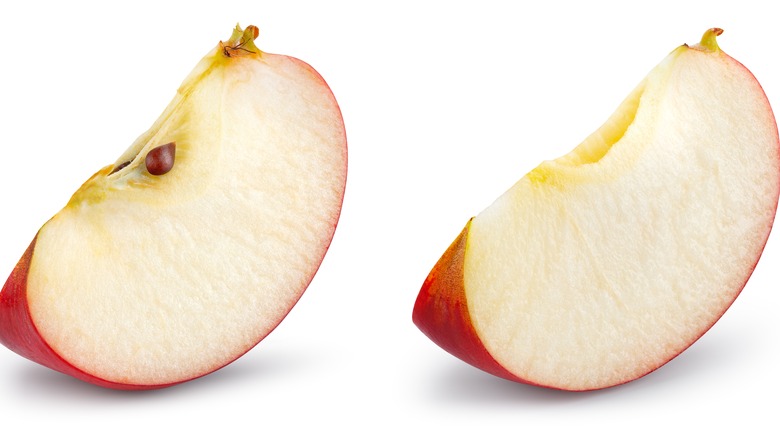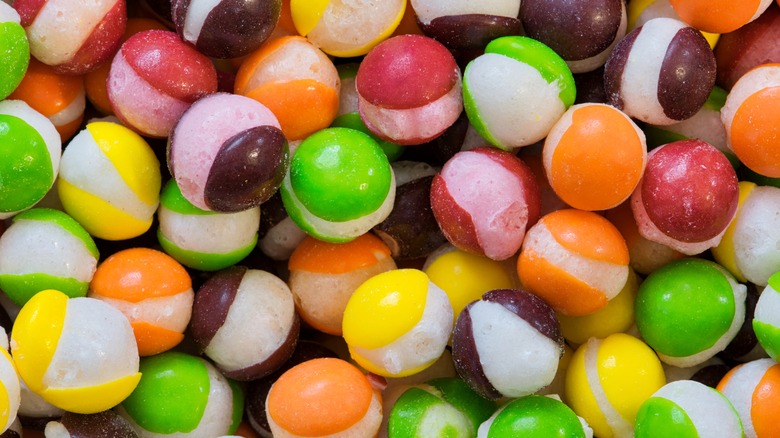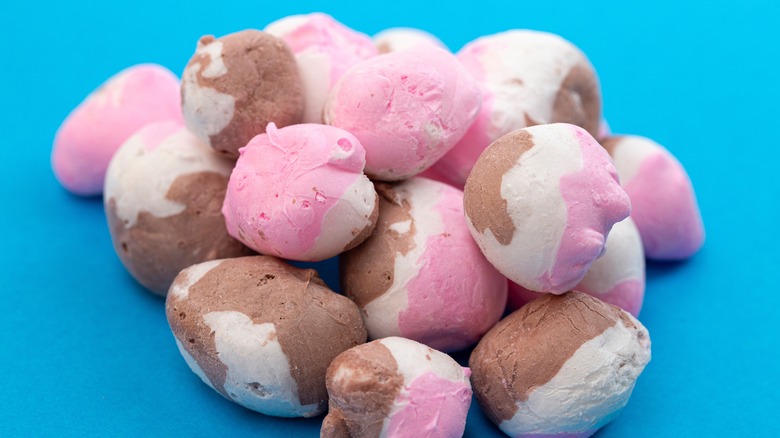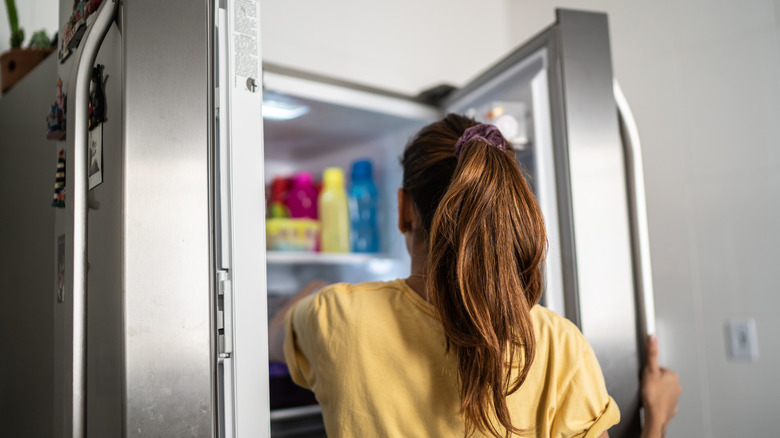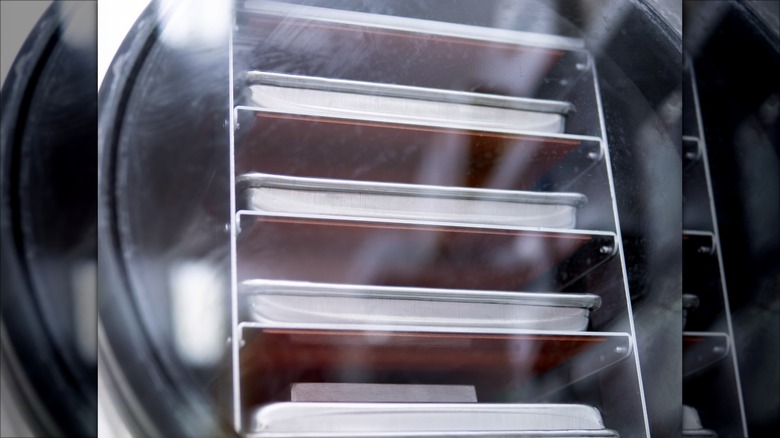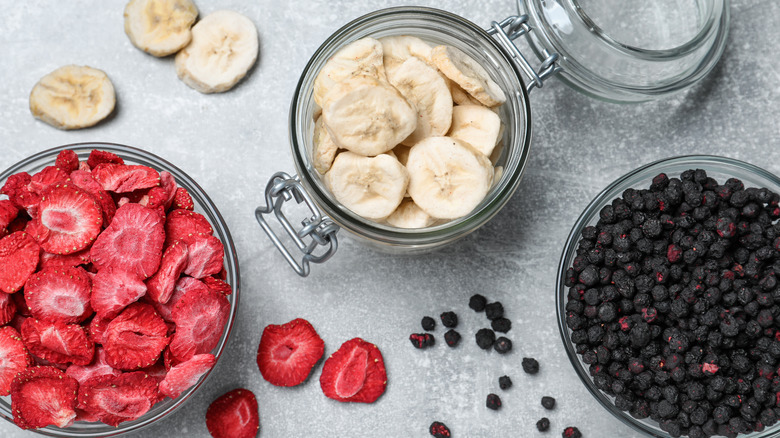17 Mistakes Everyone Makes When Freeze-Drying Foods
It doesn't take a rocket scientist to freeze-dry food ... even if astronauts are the ones we tend to associate most with this method of food preservation. They aren't the only ones who have benefited from lyophilization, however. The idea of removing the water from frozen foods has been around for centuries – the Inca froze potatoes and dried them in the sun so that they could last the entirety of a long journey. Freeze-drying as we know it is a more recent thing, however. In 1906, the method was developed by Jacques-Arsene d'Arsonval, but its popularity grew in the 1950s, when the process became associated with food preservation.
First, foods are frozen. Then comes the primary drying or sublimation phase, in which the food is heated and the pressure is reduced so that the water sublimates, aka turns straight to vapor instead of first melting back to a liquid. In the secondary drying or adsorption phase, the heat is increased so that even water molecules bound to the food are removed. All this enables the freeze-dried food to last years or even decades if properly stored.
While this may sound very sciencey, it's actually a fairly straightforward process if you avoid the mistakes covered in this article. With a bit of prep and some patience, you can freeze-dry everything from meat to vegetables to candy and extend their shelf life for years.
1. Mistake: Using big chunks of food
One of the biggest mistakes in the freeze-drying game is cutting your food into pieces that are too big. It makes sense to think that chopping things into bigger chunks will save you time, but this will lead to trouble in the long run. The bigger your pieces are, the tougher it is for your machine to remove all the moisture.
Removing as much water as possible is especially important when it comes to freeze-drying meat. Any moisture that is left behind can lead to your food getting rancid, but even if it doesn't, it will give your meat an unappealing, chewy texture that will make eating it a chore. The best thing to do is to dice your meat into very small pieces or shred it.
Regardless of which food you are freeze-drying, the thickness of your chunks or slices should never surpass 10 millimeters, and in general, the food pieces should be less than or equal to the height of the tray you are putting them in. They should also all be around the same size, so they dry evenly.
2. Mistake: Mixing fruits and vegetables with meat
The great thing about freeze-drying is that it preserves everything you are freeze-drying. The bad thing about freeze-drying is that is preserves everything you are freeze-drying. While this process does remove the moisture from your food so that it can last for decades, it also enables bacteria that may be on it to last for decades right along with it. Freeze-drying does not kill germs; it only keeps them from growing. (Scientists actually freeze-dry bacteria on purpose for use in future research.)
Pathogens on raw meat, for example, remain on that meat after freeze-drying, but this shouldn't be an issue if you then cook the meat to a proper temperature before eating it. The problem is when you freeze-dry raw meat and fresh fruit or vegetables together. It might seem like a convenient way to prep everything all at once, but the bacteria can spread from the meat onto the other items, putting you and your family in danger of food poisoning.
3. Mistake: Mixing foods that don't match
It's a bad idea to mix meat and produce on the same tray because of potential cross-contamination. But it's also a bad idea to mix other very dissimilar foods in the freeze dryer in general because they will just plain taste bad. Freeze-drying sweet foods like bananas in the same chamber as not-so-sweet ones like broccoli will lead to some strange taste combinations that will be very disappointing after all the time you put into the prep process. (Who wants to eat a banana slice that tastes like broccoli?)
This effect is lessened somewhat if you put the stronger-flavored foods such as onions on the top shelf of the machine, but even then, there's usually still a noticeable spillover of taste.
4. Mistake: Not removing enough moisture
The whole point of freeze-drying is to remove almost all the moisture from food. This is what makes it safe to eat a freeze-dried apple even if years have passed since it was plucked from the tree. However, it is very important to make sure that you are producing freeze-dried food that has been, well, sufficiently freeze-dried. Otherwise, your food may be prone to spoilage.
But how do you know if your freeze dryer has removed enough water from your foods? The rule of thumb is that your freeze-dried food should be a crisp, dry texture when it comes out of the machine, and it should be able to be broken by your hands. Sugary foods like fruit may be more bendable than breakable, but they should not be sticky.
5. Mistake: Overfilling the tray
We've all been in a hurry when baking and loaded up the cookie sheet with too many cookies too close together at one time in our lives. And, subsequently, we all have learned that this leads to problems like cookies that didn't bake properly or just one giant cookie instead of 20. This same kind of mistake is often made during the freeze-drying process.
Many amateur freeze-dryers get impatient and overload their tray with food, which causes big issues during the freezing process, namely with the buildup of ice. This leads to you having to stop and defrost before continuing with the process, which can add a lot of extra time to your freeze-drying session. To avoid this, don't heap the food onto the tray — lay it out in a flat, even layer in uniformly cut pieces or slices.
6. Mistake: Not poking the skin of your fruit
There are tons of foods that you can safely freeze-dry, but some make the process slightly longer or more difficult than others. One example of this is foods that are high in sugar or have lots of moisture inside, like fruit. These may require a longer freezing or drying time, but one thing you can do to speed things up is to pierce their skin before putting them into the chamber. Foods like grapes, blueberries, or even cherry tomatoes have a thick outer membrane, but opening them up slightly to expose the interior will better enable the machine to withdraw the moisture. The key is to puncture them with a knife or other sharp object. Or, alternatively, you can freeze-dry larger fruits diced or in slices.
7. Mistake: Not cleaning your freeze dryer properly
As with most appliances, freeze dryers need proper cleaning in order to stay functional. If you don't clean your freeze dryer after each use, this could cause clogging and other issues that could lead to a breakdown of your machine or improper freeze-drying.
To clean your freeze dryer, start by unplugging it. Then, get to work cleaning it by hand, as washing the removable parts in the dishwasher may void your freeze dryer's warranty. Wipe down the vacuum chamber and the shelves with a mild soap and water and then use a soft towel to dry them. You can take out the shelves and wash them in the sink with hot water if you'd like, but be sure that everything is completely dry before putting the shelves back in. The outside of the machine can be cleaned with warm water and a mild soap and then dried with a towel as well.
8. Mistake: Confusing a dehydrator for a freeze dryer
Freeze dryer, dehydrator — tomato, tomahto, right? Not quite! While both a dehydrator and a freeze dryer remove moisture from food in order to preserve it, the terms are not interchangeable. A freeze dryer works to remove water from food by freezing it and then decreasing the pressure inside the chamber, causing the ice inside to turn to vapor. A dehydrator, on the other hand, circulates hot air around the food to slowly reduce its moisture content.
Dehydrators tend to cost much less than freeze dryers, and they tend to be a bit more foolproof than freeze dryers when it comes to over-drying. Freeze-drying, however, is said to better maintain the flavor of the food you are preserving. At the end of the day, they are two different methods to accomplish the same goal, but they are not the same thing.
9. Mistake: Not trying other freeze-drying methods
Freeze-drying may seem like a really cool idea, but for many people, it may also seem financially out of reach. Freeze dryers can thousands of dollars, out of the price range for many. But that doesn't mean that you can't still freeze-dry food at home!
The easiest way to do this is to simply use your regular old freezer. Chop fruits or vegetables into small pieces and arrange them, evenly spaced, on a tray. Then, stick them in an empty freezer (or at least as empty as you can get it) and put it on the coldest possible setting. The food should remain where it is for at least a week, after which you can remove it and store it in a regular ziplock bag.
To make things go a bit more quickly, you can also use dry ice to freeze-dry food. Start by putting your food into ziplock bags and then pack them into a dry ice cooler with an equal ratio of dry ice to food weight. Place the lid loosely on the cooler, but do not shut it all the way because it could explode if you do. When all the dry ice has disappeared, your food should officially be freeze-dried.
10. Mistake: Setting up your freeze dryer in the wrong location
Let's just start by saying this: Freeze dryers are big. Like, really big. The freeze dryer itself weighs more than 100 pounds, and the vacuum pump weighs around 35, so you will need to pick out a very sturdy surface for it before you bring one home. It is also important to remember that this machine runs for hours or days at a time and makes fairly continuous, vacuum-cleaner-like sounds, along with some beeping, which pretty much eliminates the baby's room or the living room as a setup location.
However, the most important thing to keep in mind when you are finding a location for your freeze dryer is the temperature. Maybe you might want to keep this large, noisy thing in the garage, away from the peaceful tranquility of the house, but that could be an issue if the temperature in your garage is not stable. Freeze dryers work best in a room where the temperature is between 45 and 75 degrees Fahrenheit. Anything above or below that will make the machine less efficient and lead to poor results.
11. Mistake: Not pre-treating your fruit
Have you ever noticed how apples get brown if you don't eat them pretty much immediately after you peel or slice them? This is because they, like some other fruits, contain enzymes that break down the food once its interior is exposed to air. If you don't want your freeze-dried fruit to turn brown and unappealing, you have to do a bit of prep work before starting.
Penn State Extension recommends placing your sliced fruit pieces in a solution containing 3 ¾ teaspoons of dry ascorbic acid or ½ teaspoon of powdered citric acid mixed into 2 cups of water. Leave them there for 10 minutes and then remove them from the solution and let them dry before you start freeze-drying them. If you don't have any ascorbic or citric acid on hand, you can also use a 1:1 ratio of lemon juice to water, or very briefly blanch them in boiling water.
12. Mistake: Not freeze-drying your own candy
Are you looking for a new way to enjoy your favorite candy? So are many other candy lovers. Freeze-drying candy is a cool new way to make it last longer while preserving (and intensifying) that sugary, fruity, or chocolatey flavor. This works for almost all types of candy, from gummy bears and fruit snacks to M&Ms and chocolate bars to suckers and other hard candies. You can even freeze-dry taffy! If you don't have a freeze dryer machine already, you can also use dry ice to do this at home.
The interesting thing about freeze-drying candy is that the candy takes on a whole new texture. For most candies, this means making them light, puffy, airy, and crispy. One thing to keep in mind before you start freeze-drying your candy collection, though, is that chocolate bars need to be cut into smaller, equally sized slices. Otherwise, the moisture won't be properly removed, and your candy bar won't be dried when finished.
13. Mistake: Not making your own astronaut ice cream
Freeze-dried candy might be a thing now, but freeze-dried ice cream is the original freeze-dried food that caught the imaginations of kids everywhere. You can't help but picture yourself up in orbit as you chow down on some "astronaut ice cream," so it's no surprise that this is a popular option.
To make your own freeze-dried ice cream at home, simply place the ice cream on your freeze dryer tray, either in small scoops or in one flat layer. (If you do it in a layer, said layer should be scored with a knife for easier breakage later.) Next, freeze the tray for several hours in your regular freezer and then load it into the freeze dryer and follow the directions for your particular machine. When you're finished, you can keep this now-crunchy ice cream at room temperature for years – though we doubt it'll last that long.
14. Mistake: Not pre-freezing your food to save time
If you are looking to save a bit of time, the best shortcuts don't lie in piling up more food on the freeze dryer tray or cutting it into bigger chunks so you can work faster — they lie in the prep. One way you can speed up the freeze-drying process is by first freezing your food in the normal freezer. A half-hour before removing it from the freezer, turn on the freeze cycle on your freeze dryer for 30 minutes to cool down the chamber. Then make the swap, putting your tray into the freeze dryer and carrying on with the process as normal. This little maneuver will save you anywhere from an hour to an hour and a half of freeze-drying time.
15. Mistake: Opening the freeze dryer while it's working
Unless something has gone catastrophically wrong, there is no reason to open the freeze dryer while it is working. In fact, this could be harmful to both you and your food. There are two times when one might attempt to do this, and they are both discouraged for different reasons.
If you open the freeze dryer during the freezing phase, your skin could be damaged by the dangerously low temperature inside. Aside from possible injury, this will also cause warm air to enter the chamber, which will ruin the freezing phase of the process. It is impossible to open the machine during the low-pressure vacuum phase, but if you were to unplug the machine to stop it and open it then, it would interrupt the process and your food would not be freeze-dried properly.
16. Mistake: Not having patience
Freeze-drying is not only a great way to save food and cut down on waste, but it's also just plain cool. Unfortunately, however, that second part has given people some unrealistic expectations. If you are considering getting a freeze dryer because you think you can whip up some freeze-dried meat in 30 minutes, you are going to be sorely disappointed.
Freeze-drying generally takes between 20 and 40 hours for each batch of food. More or less time may be required based on the type of food and how much moisture it contains, but either way, you're in for quite a wait. So, while this is still a neat way to preserve things, you shouldn't go into the experience expecting it to be a quick one.
17. Mistake: Not storing your freeze-dried foods properly
While it may seem incredible, freeze-dried foods can really last for decades. But this is only if they are stored properly. Freeze-dried foods are not like frozen foods: They don't need to be kept in the freezer or even the fridge. They do need to be kept in a dry, dark place so that they are not exposed to too much heat, light, or moisture, though. Recommended places include cupboards, pantries, or windowless closets.
Your method of storage is also important. Ziplock bags can keep your freeze-dried foods preserved for a few months, but glass jars with a tight lid are better for freeze-dried foods if you place an oxygen absorber (a small packet that draws in the oxygen from its surroundings and keeps it out of the food) inside or use a vacuum sealer to remove the air. Mylar bags are the most space-efficient option, but they also need oxygen absorbers. These bags can also be resealed after opening, making them a popular choice among frequent freeze-dryers.
